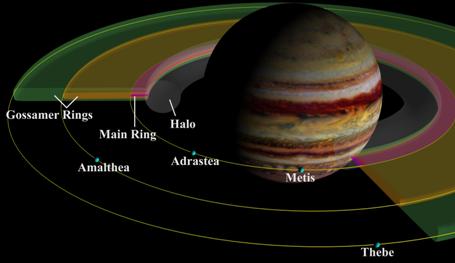We’re familiar with the rings of Saturn, but did you know that Jupiter has rings too? The rings of Jupiter were first discovered by the Voyager 1 spacecraft when it passed by Jupiter in 1979. The rings were investigated in more detail by NASA’s Galileo spacecraft during the 1990s. It was during the 1990s that Galileo and ground-based observations made a complete count of the number of Jupiter’s rings. So, how many rings does Jupiter have?
Jupiter is known to have 4 sets of rings: the halo ring, the main ring, the Amalthea gossamer ring, and the Thebe gossamer ring.
The halo ring is closest into Jupiter starting at a radius of 92,000 km and extending out to a radius of 122,500 km. The halo ring has a total width of 12,500 km.
Next is the main ring. It starts at 122,500 km and extends out to 129,000 km. It has a total width of only 6,500 km.
Outside these two major rings are the gossamer rings. These are very faint rings that are shepherded by two of Jupiter’s moons. The first is the Amalthea gossamer ring, which is shepherded by Jupiter’s moon Amalthea. It starts at a radius of 129,000 km from Jupiter and goes out to the orbit of Amalthea at 182,000 km.
Overlapping the Amalthea ring is the Thebe gossamer ring. It starts at a radius of 129,000 and goes out to a radius of 226,000 km.
How many rings does Jupiter have? The answer is four. Of course, it’s always possible that new rings will be discovered around Jupiter as new and better spacecraft and telescopes examine the planet.
We have written many articles about Jupiter and its rings for Universe Today. Here’s an article about how Jupiter’s rings are made in the shade. And here are some interesting discoveries made by NASA’s New Horizon’s spacecraft when it arrived at Jupiter.
Windows to the Universe has more information about Jupiter’s rings. And here’s more information on the rings from NASA.
We have recorded a whole episode of Astronomy Cast just about Jupiter, and in that episode we talked about the planet’s rings.
Reference:
NASA

